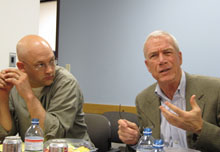Event
Clergy scandal shows power of old and new media

April 20, 2010 — At the final Shorenstein Center Speaker Series of the semester, Walter Robinson and Clay Shirky discussed how the case of the sex abuse scandal in the Catholic Church illustrates the changing powers of old and new media.
Robinson, Distinguished Professor of Journalism at Northeastern University, is a former Boston Globe Pulitzer Prize–winning journalist who along with the Spotlight Team unearthed the clergy sex abuse scandal in 2002. Robinson said that when he took on the case in 2001, he wasn’t aware of the many other cases in the 80s and 90s of sex abuse that, like the Globe story, were initially reported on the local level. In the next months, Robinson’s Spotlight investigation released documents of abusive priests that the Boston Archdiocese had kept since the 1920s. “In order to engage our readers, we had a tip line that we posted,” Robinson said. They were “flooded with phone calls from around the world,” and the “story spread like wildfire.”
Shirky, who teaches at New York University and writes on the social and economic effects of Internet technologies, noted that although the issue had existed around the world for decades, “it took until 2002 for the story to become a synchronizing story, not just an event.” In the days following the Spotlight story, there was a “superdistribution” of the story through new media channels.
New media technologies allowed opportunities for people to form organizations, such as Voice of the Faithful, and coordinate themselves, instead of being “outraged in isolation,” Shirky said. The Internet became “more than a tool for distribution of information … it also becomes a site of coordination.” Giving voice to lay Catholics, new media tools “not only allow people to network and coordinate,” Shirky noted, “but to do so in a way that cuts across national boundaries, language boundaries and church hierarchy.”
The irony is, according to Shirky, that this “world-changing investigative story … is coming at a time when the very medium that enables this kind of subsequent superdistribution … is also destroying the economic model the Globe used to support the work in the first place.” As new media makes investigative resources more widely available, it is wrecking its advertising base.
This article was written by Janell Sims and the photos taken by Annalese Duprey, both of the Shorenstein Center.